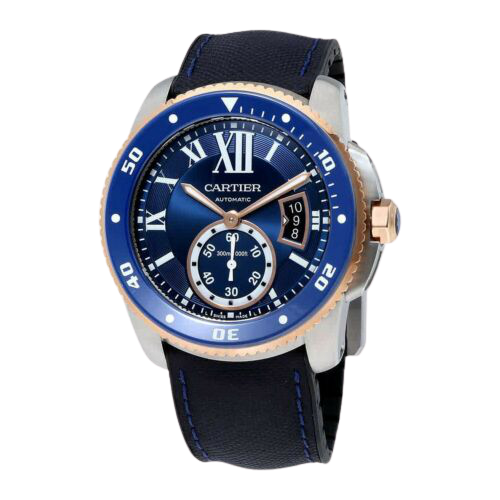Introduction to the Calibre de Cartier
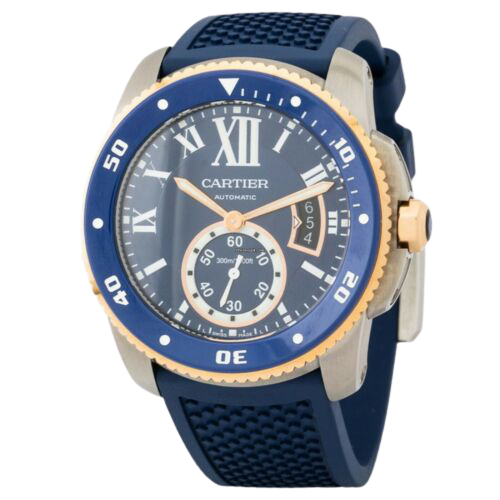
Released in 2010, the Calibre de Cartier debuted as the French manufacturer’s flagship sports watch. The Calibre was the first watch collection by the historic French maison to use the in-house manufactured movements they had designed for their “haute horlogerie” line a few years prior. In doing so, the Calibre demonstrated Cartier’s commitment to being taken seriously for both its beauty and technical sophistication.
In-House Movement: the Calibre's Beating Heart
Cartier is known for its elegant, visually striking designs. However, as watch shoppers grew savvier in recent decades, Cartier increasingly met criticism for using off-the-shelf movements in their watches. Consumers wanted watches that were as meticulously curated on the inside as they were on the outside.
The first Calibre de Cartier featured the 1904-PS MC movement, or caliber, that gives the line its name. This caliber was designed by world-renowned Swiss horologist Carole Forestier-Kasapi and is produced in Cartier’s relatively new facility in La Chaux-de-Fonds in Switzerland. It features an astounding number of technical advancements that allow the watch to run smoother, longer and with greater accuracy than previous Cartier production models.
The 1904-PS is a self-winding automatic mechanism with 48-hour power reserve that drives the hour and minute hands, a running seconds subdial at the 6 o’clock position and a rotating date window at 3 o’clock. While those features are fairly standard, the in-house mechanism of the Calibre de Cartier achieves them in a more sophisticated way. Here, two barrels (not the usual single barrel) are employed to keep the time accurately throughout every phase of the power reserve. The Calibre will keep consistent time even if you don’t wear for it a day or two. Similarly, the normal motion of the rotor is facilitated not by oil but by ceramic ball bearings. This has the double benefit of making the mechanism more resistant to shocks and extending the time between repairs.
Simply put, the Calibre is the first wide-production line from Cartier to showcase a movement as sophisticated and revolutionary as its design aesthetic.
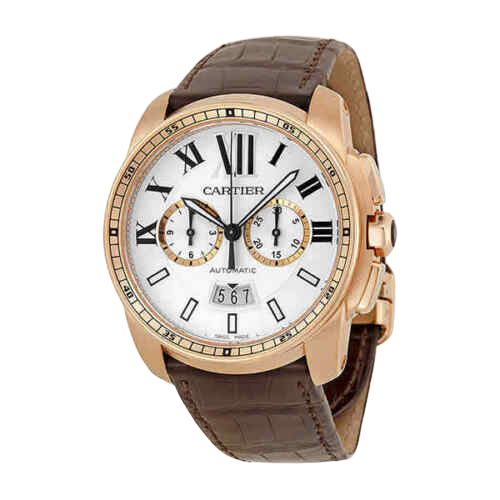
Calibre Release History
and Features
and Features
The first Calibre de Cartier was released in a single size (42mm) with a leather strap and only the simple suite of features mentioned above – hour, minute, running seconds and date indicators. It came in only a few colorways: stainless steel with black or silver dial, pink gold with a brown or silver dial, and a two-tone steel-pink gold hybrid with a brown or silver dial.
The next year, the Calibre de Cartier collection added metal bracelets but changed relatively little about the watch's aesthetics or design. The line still featured the same case size and the same in-house movement in all its variations.
In 2012, Cartier took yet another big step forward in establishing its serious watchmaking credentials: the Calibre chronograph. This watch features Cartier’s first in-house chronograph mechanism, also designed by Carole Forestier-Kasapi and based on the 1904-PS MC. The Calibre chronograph builds on the success of the standard mechanism with equal technical sophistication, incorporating not only a column wheel but a vertical clutch that prevents the chronograph from disrupting the normal timekeeping when you start, stop or reset it.

The Calibre de Cartier completed its technical evolution in 2013, with the release of the Calibre Diver. The diving edition shares all the technical sophistication of previous Calibre editions, including the same 1904-PS movement found in the standard Calibre, but adds the features necessary for a true dive watch (300m water resistance, salt water resistance, etc.). It even meets the incredibly strict ISO 6425 standards, which many luxury “dive watches” do not. It was also the slimmest dive watch in the world when it was released.
The last expansion to the product line came in 2015, when Cartier released the Calibre 38, a smaller 38mm version for those with smaller wrists. This expanded the line’s appeal to women. Some Calibre 38s were even released with diamond-encrusted bezels or fully diamond-paved faces.
A Modern Watch for a Modern Man
Despite being recently discontinued, the Calibre was an exciting development in Cartier’s history and a great collector’s item. It represented a significant step towards competing in the space shared by such venerable timepieces as the Rolex Submariner and Omega Speedmaster Omega Speedmaster Dark Side of the Moon.
The Calibre's exquisite in-house mechanism can go toe-to-toe with other big players, many of whom now use in-house calibers. More than that, the Calibre showed that Cartier could effectively bring features it had created for its Fine Watchmaking series to a wider audience at a more accessible price point, as the Calibre was priced in the middle of the range for Cartier. Finally, the product line’s youth and more modest price point make it even more appealing on the secondary market, where excellent quality examples can be found relatively easily.
All of this combine in a strikingly contemporary form factor, making the Calibre de Cartier a perfect fit for a young, active audience that wants classical elegance paired with the outstanding durability and technical sophistication of modern horological mastery.
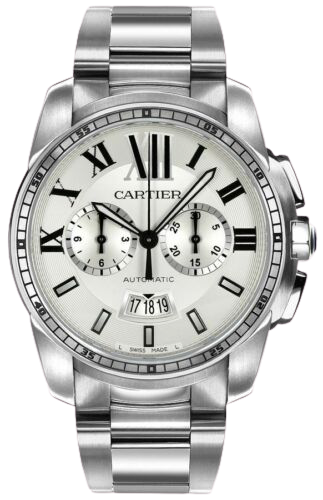
Care &
Maintenance
The Calibre is an exceptionally durable watch, but attention to care and maintenance will ensure that your investment lasts a lifetime. Clean the watch periodically with a soft, dry cloth (the type used for cleaning glasses). Maintain the finish by protecting it from bumps and shocks (such as from high-impact sports) and take it off while you sleep. Avoid wearing your watch in extreme environments such as saunas or around strong magnets.
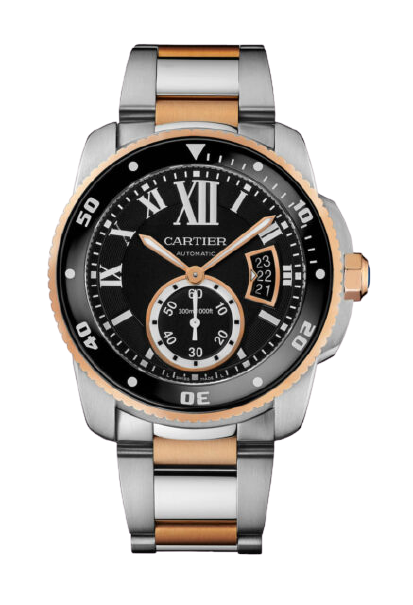
Watchmaker's Perspective
Column wheel chronographs are well regarded by watch collectors and watchmakers alike, and the 1904-CH MC movement in the Calibre de Cartier Chronograph makes good use of the mechanism. But why is it so well regarded, and how does it work?
Column wheel chronographs are known for having a smooth feeling when starting, stopping and resetting the mechanism. The actuation is near instantaneous, making the act of actually using the chronograph very satisfying. Column wheel mechanisms resemble a castle turret, with ratchet style teeth at their bath. The ratchet style teeth are used to push the column wheel forward when the start or stop button is pushed, and a finger falls in between the upright teeth of the castle turret to start and stop the mechanism.
This improved functionality doesn't come for free—the column wheel is notoriously difficult to manufacture. It is a part that needs to be turned on a lathe for maximum concentricity and milled to achieve the upright castle turret style teeth. It is easy to admire the effort that goes into manufacturing a part this complex, at this scale. Cartier makes it all look easy with their sleek and stylish Calibre de Cartier Chronograph.
